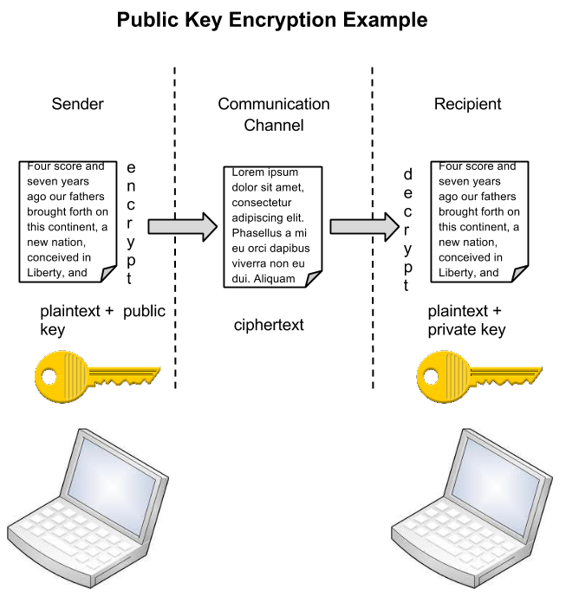6.3.3: Encryption
- Page ID
- 84146
\( \newcommand{\vecs}[1]{\overset { \scriptstyle \rightharpoonup} {\mathbf{#1}} } \)
\( \newcommand{\vecd}[1]{\overset{-\!-\!\rightharpoonup}{\vphantom{a}\smash {#1}}} \)
\( \newcommand{\id}{\mathrm{id}}\) \( \newcommand{\Span}{\mathrm{span}}\)
( \newcommand{\kernel}{\mathrm{null}\,}\) \( \newcommand{\range}{\mathrm{range}\,}\)
\( \newcommand{\RealPart}{\mathrm{Re}}\) \( \newcommand{\ImaginaryPart}{\mathrm{Im}}\)
\( \newcommand{\Argument}{\mathrm{Arg}}\) \( \newcommand{\norm}[1]{\| #1 \|}\)
\( \newcommand{\inner}[2]{\langle #1, #2 \rangle}\)
\( \newcommand{\Span}{\mathrm{span}}\)
\( \newcommand{\id}{\mathrm{id}}\)
\( \newcommand{\Span}{\mathrm{span}}\)
\( \newcommand{\kernel}{\mathrm{null}\,}\)
\( \newcommand{\range}{\mathrm{range}\,}\)
\( \newcommand{\RealPart}{\mathrm{Re}}\)
\( \newcommand{\ImaginaryPart}{\mathrm{Im}}\)
\( \newcommand{\Argument}{\mathrm{Arg}}\)
\( \newcommand{\norm}[1]{\| #1 \|}\)
\( \newcommand{\inner}[2]{\langle #1, #2 \rangle}\)
\( \newcommand{\Span}{\mathrm{span}}\) \( \newcommand{\AA}{\unicode[.8,0]{x212B}}\)
\( \newcommand{\vectorA}[1]{\vec{#1}} % arrow\)
\( \newcommand{\vectorAt}[1]{\vec{\text{#1}}} % arrow\)
\( \newcommand{\vectorB}[1]{\overset { \scriptstyle \rightharpoonup} {\mathbf{#1}} } \)
\( \newcommand{\vectorC}[1]{\textbf{#1}} \)
\( \newcommand{\vectorD}[1]{\overrightarrow{#1}} \)
\( \newcommand{\vectorDt}[1]{\overrightarrow{\text{#1}}} \)
\( \newcommand{\vectE}[1]{\overset{-\!-\!\rightharpoonup}{\vphantom{a}\smash{\mathbf {#1}}}} \)
\( \newcommand{\vecs}[1]{\overset { \scriptstyle \rightharpoonup} {\mathbf{#1}} } \)
\( \newcommand{\vecd}[1]{\overset{-\!-\!\rightharpoonup}{\vphantom{a}\smash {#1}}} \)
\(\newcommand{\avec}{\mathbf a}\) \(\newcommand{\bvec}{\mathbf b}\) \(\newcommand{\cvec}{\mathbf c}\) \(\newcommand{\dvec}{\mathbf d}\) \(\newcommand{\dtil}{\widetilde{\mathbf d}}\) \(\newcommand{\evec}{\mathbf e}\) \(\newcommand{\fvec}{\mathbf f}\) \(\newcommand{\nvec}{\mathbf n}\) \(\newcommand{\pvec}{\mathbf p}\) \(\newcommand{\qvec}{\mathbf q}\) \(\newcommand{\svec}{\mathbf s}\) \(\newcommand{\tvec}{\mathbf t}\) \(\newcommand{\uvec}{\mathbf u}\) \(\newcommand{\vvec}{\mathbf v}\) \(\newcommand{\wvec}{\mathbf w}\) \(\newcommand{\xvec}{\mathbf x}\) \(\newcommand{\yvec}{\mathbf y}\) \(\newcommand{\zvec}{\mathbf z}\) \(\newcommand{\rvec}{\mathbf r}\) \(\newcommand{\mvec}{\mathbf m}\) \(\newcommand{\zerovec}{\mathbf 0}\) \(\newcommand{\onevec}{\mathbf 1}\) \(\newcommand{\real}{\mathbb R}\) \(\newcommand{\twovec}[2]{\left[\begin{array}{r}#1 \\ #2 \end{array}\right]}\) \(\newcommand{\ctwovec}[2]{\left[\begin{array}{c}#1 \\ #2 \end{array}\right]}\) \(\newcommand{\threevec}[3]{\left[\begin{array}{r}#1 \\ #2 \\ #3 \end{array}\right]}\) \(\newcommand{\cthreevec}[3]{\left[\begin{array}{c}#1 \\ #2 \\ #3 \end{array}\right]}\) \(\newcommand{\fourvec}[4]{\left[\begin{array}{r}#1 \\ #2 \\ #3 \\ #4 \end{array}\right]}\) \(\newcommand{\cfourvec}[4]{\left[\begin{array}{c}#1 \\ #2 \\ #3 \\ #4 \end{array}\right]}\) \(\newcommand{\fivevec}[5]{\left[\begin{array}{r}#1 \\ #2 \\ #3 \\ #4 \\ #5 \\ \end{array}\right]}\) \(\newcommand{\cfivevec}[5]{\left[\begin{array}{c}#1 \\ #2 \\ #3 \\ #4 \\ #5 \\ \end{array}\right]}\) \(\newcommand{\mattwo}[4]{\left[\begin{array}{rr}#1 \amp #2 \\ #3 \amp #4 \\ \end{array}\right]}\) \(\newcommand{\laspan}[1]{\text{Span}\{#1\}}\) \(\newcommand{\bcal}{\cal B}\) \(\newcommand{\ccal}{\cal C}\) \(\newcommand{\scal}{\cal S}\) \(\newcommand{\wcal}{\cal W}\) \(\newcommand{\ecal}{\cal E}\) \(\newcommand{\coords}[2]{\left\{#1\right\}_{#2}}\) \(\newcommand{\gray}[1]{\color{gray}{#1}}\) \(\newcommand{\lgray}[1]{\color{lightgray}{#1}}\) \(\newcommand{\rank}{\operatorname{rank}}\) \(\newcommand{\row}{\text{Row}}\) \(\newcommand{\col}{\text{Col}}\) \(\renewcommand{\row}{\text{Row}}\) \(\newcommand{\nul}{\text{Nul}}\) \(\newcommand{\var}{\text{Var}}\) \(\newcommand{\corr}{\text{corr}}\) \(\newcommand{\len}[1]{\left|#1\right|}\) \(\newcommand{\bbar}{\overline{\bvec}}\) \(\newcommand{\bhat}{\widehat{\bvec}}\) \(\newcommand{\bperp}{\bvec^\perp}\) \(\newcommand{\xhat}{\widehat{\xvec}}\) \(\newcommand{\vhat}{\widehat{\vvec}}\) \(\newcommand{\uhat}{\widehat{\uvec}}\) \(\newcommand{\what}{\widehat{\wvec}}\) \(\newcommand{\Sighat}{\widehat{\Sigma}}\) \(\newcommand{\lt}{<}\) \(\newcommand{\gt}{>}\) \(\newcommand{\amp}{&}\) \(\definecolor{fillinmathshade}{gray}{0.9}\)Encryption
Many times an organization needs to transmit information over the Internet or transfer it on external media such as a flash drive. In these cases, even with proper authentication and access control, it is possible for an unauthorized person to gain access to the data. Encryption is a process of encoding data upon its transmission or storage so that only authorized individuals can read it. This encoding is accomplished by software which encodes the plain text that needs to be transmitted (encryption). Then the recipient receives the cipher text and decodes it (decryption). In order for this to work, the sender and receiver need to agree on the method of encoding so that both parties have the same message. Known as symmetric key encryption, both parties share the encryption key, enabling them to encode and decode each other’s messages.
An alternative to symmetric key encryption is public key encryption. In public key encryption, two keys are used: a public key and a private key. To send an encrypted message, you obtain the public key, encode the message, and send it. The recipient then uses their private key to decode it. The public key can be given to anyone who wishes to send the recipient a message. Each user simply needs one private key and one public key in order to secure messages. The private key is necessary in order to decrypt a message sent with the public key.
Notice in the image how the sender on the left creates a plaintext message which is then encrypted with a public key. The ciphered text is transmitted through the communication channel and the recipient uses their private key to decrypt the message and then read the plain text.

Sidebar: Blockchain and Bitcoin
Blockchain
Introduced in 2008 as part of a proposal for Bitcoin, Blockchain is a peer-to-peer network which provides an open, distributed record of transactions between two parties. A “peer-to-peer” network is one where there is no server between the two nodes trying to communicate. Essentially, this means that each node acts as a server and a client.
Supporters see blockchain as a tool to simplify all types of transactions: payments, contracts, etc. Motivation comes from the desire to remove the middleman (lawyer, banker, broker) from transactions, making them more efficient and readily available across the Internet. Blockchain is already being used to track products through supply chains.
Blockchain is considered a foundational technology, potentially creating new foundations in economics and social systems. There are numerous concerns about Blockchain and its adoption. Consider the following:
- Speed of adoption. Initially there is a great deal of enthusiasm by a small group. However, adoption on a larger scale can take a great number of years even decades for a worldwide acceptance of a new method of doing business.
- Governance. The banking sector, both in individual countries (U. S. Federal Reserve System) and the world at large (the International Monetary Fund), controls financial transactions. One purpose of these organizations is an attempt to avoid banking and financial systems collapse. Blockchain will result in the governance of financial transactions shifting away from these government-controlled institutions.
- Smart contracts. The smart contract will re-shape how businesses interact. It is possible for blockchain to automatically send payment to a vendor the instant the product is delivered to the customer. Such “self-executing” contracts are already taking place in banking and venture capital funding. [9]
Many are forecasting some universal form of payment or value transfer for business transactions. Blockchain and Bitcoin are being used to transform banking in various locations around the world. The following Bitcoin section includes a look at a new banking venture in Tanzania, East Africa.
Bitcoin

Bitcoin is a world wide payment system using cryptocurrency. It functions without a central bank, operating as a peer-to-peer network with transactions happening directly between vendors and buyers. Records for transactions are recorded in the blockchain. Bitcoin technology was released in 2009. The University of Cambridge estimated there were 2.9 and 5.8 million unique users of bitcoin in 2017.[10] This web site provides more information about bitcoin.
A major bitcoin project is underway in Tanzania. Business transactions in this East African country are fraught with many challenges such as counterfeit currency and a 28% transaction fee on individuals who do not have a bank account. Seventy percent of the country’s population fall into this category. Benjamin Fernandes, a Tanzanian and 2017 graduate of Stanford Graduate School of Business, is co-founder of NALA, a Tanzanian firm working to bring cryptocurrency to a country where 96% of the population have access to mobile devices. NALA’s goal is to provide low cost transactions to all of the country’s citizens through cryptocurrency.[11] You can read more of this cryptocurrency venture here.


